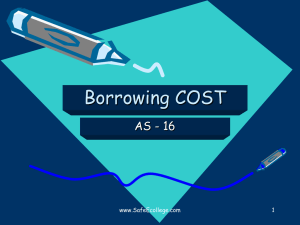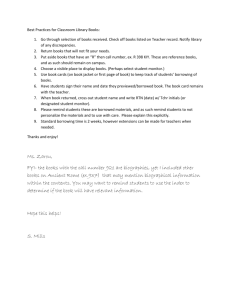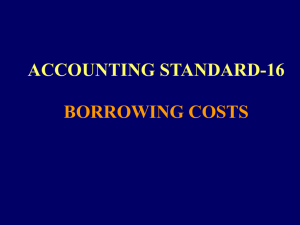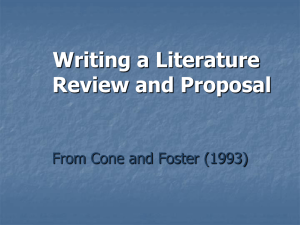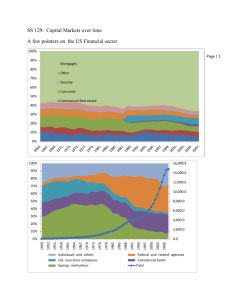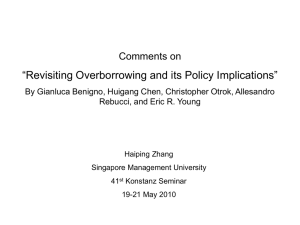TOPIC 3 BORROWING COST (MASB 27) INTRODUCTION
advertisement
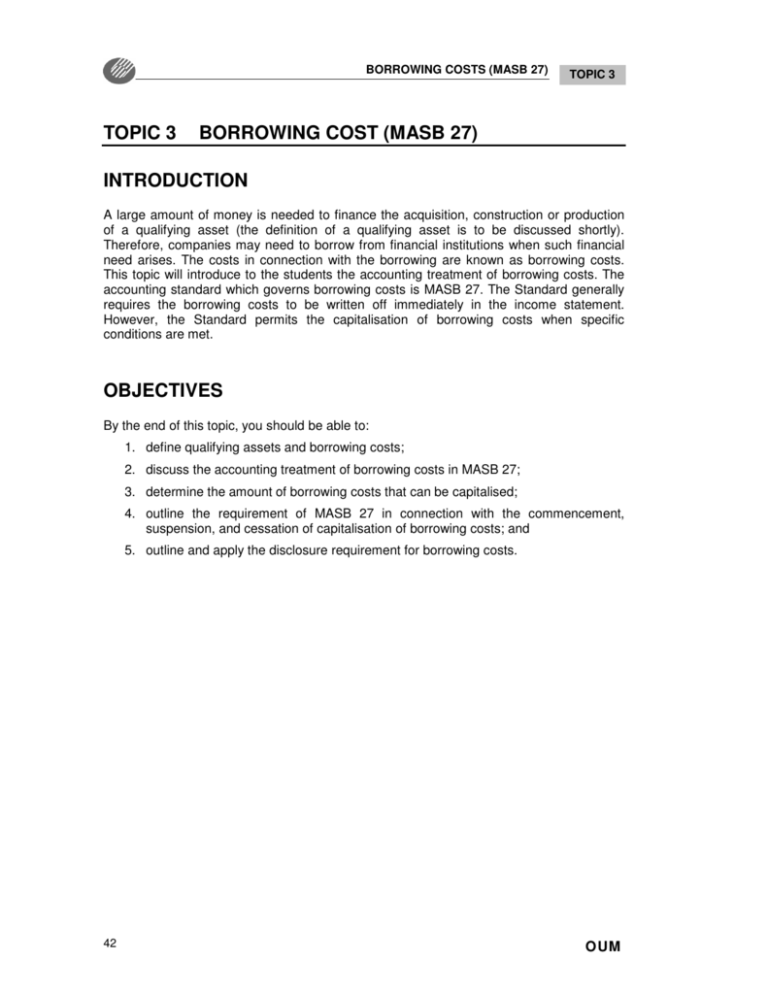
BORROWING COSTS (MASB 27) TOPIC 3 TOPIC 3 BORROWING COST (MASB 27) INTRODUCTION A large amount of money is needed to finance the acquisition, construction or production of a qualifying asset (the definition of a qualifying asset is to be discussed shortly). Therefore, companies may need to borrow from financial institutions when such financial need arises. The costs in connection with the borrowing are known as borrowing costs. This topic will introduce to the students the accounting treatment of borrowing costs. The accounting standard which governs borrowing costs is MASB 27. The Standard generally requires the borrowing costs to be written off immediately in the income statement. However, the Standard permits the capitalisation of borrowing costs when specific conditions are met. OBJECTIVES By the end of this topic, you should be able to: 1. define qualifying assets and borrowing costs; 2. discuss the accounting treatment of borrowing costs in MASB 27; 3. determine the amount of borrowing costs that can be capitalised; 4. outline the requirement of MASB 27 in connection with the commencement, suspension, and cessation of capitalisation of borrowing costs; and 5. outline and apply the disclosure requirement for borrowing costs. 42 OUM TOPIC 3 BORROWING COSTS (MASB 27) MIND MAP 3.1 DEFINITION 3.1.1 Qualifying Assets Let’s look at the definition of two important terms used in MASB27, they are: (i) Qualifying assets; and (ii) Borrowing costs. Based on Paragraph 3 of MASB 27, a qualifying asset is an asset that necessarily takes a substantial period of time to get ready for its intended use or sale. MASB 27, however, does not specify the length of “a substantial period”. Generally, if an asset is ready for its intended use or sale when it is acquired then it will not satisfy the definition of a qualifying asset. OUM 43 BORROWING COSTS (MASB 27) TOPIC 3 The examples of qualifying assets given in paragraph 5 of MASB27 are: (i) Inventories that require a substantial period of time to bring them to a saleable condition; (ii) Manufacturing plants; (iii) Power generation facilities; and (iv) Investment properties. On the other hand, MASB 27 excludes the following from the definition of qualifying asset: (i) Inventories that are routinely manufactured or otherwise produced in large quantities on a repetitive basis over a short period of time; and (ii) Assets that are ready for their intended use or sale when acquired. 3.1.2 Borrowing Cost Paragraph 3 of MASB 27 defines borrowing costs as the interest and other costs incurred by an enterprise in connection with the borrowing of funds. Borrowing costs may include: (i) Interest on bank overdrafts and short-term and long-term borrowings; (ii) Amortisation of discounts or premiums relating to borrowings; (iii) Amortisation of ancillary costs incurred in connection with the arrangement of borrowings; (iv) Finance charges in respect of finance leases recognised in accordance with MASB 10, Leases; and (v) Exchange differences arising from foreign currency borrowings to the extent that they are regarded as an adjustment to interest costs. List the qualifying assets in your company. 3.2 THE ACCOUNTING TREATMENT OF BORROWING COSTS Let’s find out the accounting treatment of borrowing costs now. Basically, MASB27 allows borrowing costs to be treated in the following ways: 44 OUM TOPIC 3 BORROWING COSTS (MASB 27) 3.2.1 Benchmark Treatment Based on the benchmark treatment of MASB 27, borrowing costs should be recognized as an expense in the period in which they are incurred regardless of how the borrowings are applied. 3.2.2 Allowed Alternative Treatment Under the allowed alternative treatment of MASB 27, borrowing costs that are directly attributable to the acquisition, construction or production of a qualifying asset should be capitalised as part of the costs of that asset. Otherwise, the cost should be expensed. From a company’s perspective, what are the pros and cons of writing off borrowing costs in the income statement? 3.3 CAPITALISATION OF BORROWING COSTS Since the accounting standard allows the borrowing costs to be capitalised, we shall need to find out the following issues: (i) What is the amount of borrowing costs to be capitalised? (ii) When shall be the commencement of the capitalisation?. (iii) When shall we suspense the capitalisation? (iv) When shall we cease the capitalisation? The answers for the above questions will be given in the following sections. 3.3.1 Amount to be Capitalised The amount of borrowing costs that can be capitalised as part of the cost of a qualifying asset are those borrowing costs that would have been avoided if the expenditure on the qualifying asset had not been made (MASB27, para 11). Paragraph 15 of MASB 27 states that the funds that are borrowed specifically for a qualifying asset, the amount of borrowing costs that are allowed to be capitalised will be the actual borrowing costs incurred during the period less any investment income on the temporary investment of that borrowing. However, to the extent that funds are borrowed generally and used for the purpose of obtaining a qualifying asset, the amount of borrowing costs eligible for capitalisation should be determined by applying a capitalisation rate to the expenditure on that asset. The capitalisation rate in this case should be the weighted average of the borrowing costs (MASB 27, para 17). The principle of capitalisation of borrowing costs and the amount to be capitalised are shown in Figure 1 OUM 45 BORROWING COSTS (MASB 27) Are the borrowing directly attributes to the acquisition, construction or production of a qualifying assets? TOPIC 3 Recognised as an expense. Capitalise as part of a cost of qualifying asset. Were the funds involved a general borrowing or a borrowing specifically for the qualifying assets? Actual borrowing costs capitalised to the extent that the borrowing is expected to be used for qualifying asset. Investment revenue earned on such funds must be deducted from borrowing costs incurred. Amount of borrowing costs to be capitalised determined by applying a weighted average borrowing rate / applicable to general borrowing outstanding during the reporting period) to the weighted average accumulated expenditure relating to qualifying assets during the reporting period. Figure 3.1: The principle of capitalisation of borrowing costs and the amount to be capitalised Source: Adopted from Jones & Rivett (1999) Example 1 Sungai Emas Sdn. Bhd. is an established property development company in Klang Valley. In the middle of the year 2000, the company obtained a project to construct 100 units of residential houses in Kajang. A 10 percent interest bearing term loan of RM450 million was arranged to part-finance the project. The term loan was fully drawn down on 1 November 2002. The project commenced on 1 November 2002 and was completed on 31 December 2005. From the period of 2002 to 2005, surplus fund from the loan were invested in money market instruments. 46 OUM TOPIC 3 BORROWING COSTS (MASB 27) The interest incomes were as follows: Interest Income RM'000 Period investment From 1 November 2002 to 31 December 2002 From 1 January 2003 to 31 December 2003 From 1 January 2004 to 31 December 2004 From 1 January 2005 to 31 December 2005 20 450 200 50 Total interest income 720 The associated interest costs on the loan were as follows: Interest Costs RM'000 Period incurred From 1 November 2002 to 31 December 2002 From 1 January 2003 to 31 December 2003 From 1 January 2004 to 31 December 2004 From 1 January 2005 to 31 December 2005 5,000 13,000 12,000 15,000 Total interest income 45,000 Required Calculate the amount of interest that should be capitalised in each year. Solution The borrowing costs incurred specifically for a qualifying asset, the amount of borrowing costs that are allowed to be capitalised will be the actual borrowing costs incurred during the period less any investment income on the temporary investment of that borrowing. Year 2002 2003 2004 2005 OUM Interest costs incurred RM’000 Interest income RM’000 Borrowing costs capitalised 5,000 13,000 12,000 15,000 20 450 200 50 4,980 12,550 11,800 14,950 RM’000 47 BORROWING COSTS (MASB 27) TOPIC 3 Example 2 Wong and Tan Sdn. Bhd., a property development company, has the following loans in place at the beginning of the year 2005. Amount borrowed RM'000 A term loan from bank A foreign currency loan 50,000 100,000 Total 150,000 Rate of interest % 10 6 On 1 January 205, Wong and Tan began a project to construct a condominium. For the year 2005, the project will utilize RM120,000,000 from the existing borrowings. Expenditure drawn down for the construction was as follows: (i) (ii) RM70,000,000 on 1 January 2005; and RM50,000,000 on 1 July 2005 Required Calculate the borrowing costs to be capitalised for the project of the constructing condominium. Solution The capitalisation rate =weighted average rate = (10% x RM50,000,00/150,000,000) + (6% x RM100,000,000/RM150,000,000) = 7.3% Borrowing costs = (RM70,000,000 x 7.3%) + (M50,000 x 7.3% x ½) = RM6,935,000 3.3.2 Commencement of Capitalisation The capitalisation of borrowing costs should commence when: (i) Expenditures for the asset are being incurred; (ii) Borrowing costs are being incurred; and (iii) Activities that are necessary to prepare the asset for its intended use or sale are in progress. 48 OUM TOPIC 3 BORROWING COSTS (MASB 27) Example 3 On 1 January 2004, Tan & Tan Sdn. Bhd. bought a piece of land which costs RM3 million for construction of a factory. In order to finance the cost of the land, a loan was obtained. The company needs to pay 9 percent interest per annum for the loan. Due to some reasons, the construction did not start until 1 June 2005. Required Discuss the treatment of the borrowing costs. Solution The borrowing costs incurred for the year 2004 should not be capitalised. Borrowing costs should be capitalised when development work commenced from 1 June 2005. 3.3.3 Suspension of Capitalisation Capitalisation of borrowing costs should be suspended during extended periods in which active development is interrupted (MASB 27, para 23). Paragraph 24 of MASB 27 outlines the following circumstances to be excluded from suspension of capitalisation of borrowing costs: (i) Where substantial technical and administrative work is being carried out; (ii) Where a temporary delay is a necessary part of the process of getting an asset ready for its intended use or sale. For example, capitalisation continues during the extended period needed for inventories to mature or the extended period during which high water levels delay construction of a bridge, if such high water levels are common during the construction period in the geographic region involved. Example 4 Aceland Sdn. Bhd. is a construction company in Kelantan. The recent heavy rain has caused a severe land slide in the area where the major project of the company situated. The relevant authority advised that the construction has to be temporary stopped until further notice. Based on past experience, such situation will normally cause a temporary delay of one month. Required Discuss the treatment of the borrowing costs. Solution Paragraph 23 of MASB 27 requires that capitalisation of borrowing costs should be suspended during the extended periods in which active development is interrupted. However paragraph 24 of MASB 27 further explains that when there is a temporary interruption caused by bad weather, shortages of workers and etc, capitalisation of OUM 49 BORROWING COSTS (MASB 27) TOPIC 3 borrowing costs should continue if it is reasonably certain that the development will be resumed shortly. 3.3.4 Cessation of Capitalisation Capitalisation of borrowing costs should cease when all the activities necessary to prepare the qualifying asset for its intended use or sale are substantially completed (MASB 27, para 25). Example 5 On 1 June 2005, the construction of a shop is completed. However, minor modification of the garage needed to be done. Required Discuss the treatment of the borrowing costs. Solution An asset is normally ready for its intended use or sale when the physical construction of the asset is completed even though routine administrative work might still continue. If minor modifications are needed to suit the purchaser’s or user’s specifications, this indicates that are the activities are substantially completed. Therefore, In this case, the capitalisation of borrowing costs should cease with effect from 1 June 2005. 3.4 DISCLOSURE The financial statements should disclose: (i) The accounting policy adopted for borrowing costs; (ii) The amount of borrowing costs capitalised during the period; and (iii) The capitalisation rate used to determine the amount of borrowing costs eligible for capitalisation Find out how borrowing costs are presented and disclosed in the annual audited accounts from the website of Bursa Malaysia at http://www.klse.com.my 50 OUM TOPIC 3 BORROWING COSTS (MASB 27) The following example is taken from the notes to the accounts of an annual report of two Malaysian companies namely, Telekom Malaysia Berhad and Jaks Resource Berhad. They illustrate the disclosure practice which adopted the policy of capitalisation (Telekom Malaysia Berhad) and written off (Jaks Resource Berhad) of borrowing costs. Example 6 Telekom Malaysia Berhad Year ended 31 December 2005 Extract from notes to accounts Significant Accounting Policies Finance Cost Costs incurred in connection with the financing of the construction and installation of property, plant and equipment is capitalised until the property, plant and equipment are ready for their intended use. Jaks Resource Berhad Year ended 31 October 2005 Extract from notes to accounts Significant Accounting Policies Borrowing Costs Borrowing costs are charged to the income statement as an expense in the period in which they are incurred. SUMMARY Extensive qualifying assets are needed as business grows. To finance these qualifying assets, external fund may be required. The cost of obtaining these external funds is referred as borrowing costs. The accounting treatments of borrowing costs are discussed. Finally, this chapter outlines the presentation and disclosure of borrowing costs under the requirement of MASB 27. Students are to be informed that MASB 27 was replaced by FRS 123 with effect from 1 January 2006 for non-private entities in Malaysia. A private entity is a private company, incorporated under the Companies Act 1965, that: • OUM is not itself required to prepare or lodge any financial statements under any law administered by the Securities Commission or the Bank Negara Malaysia; and 51 BORROWING COSTS (MASB 27) • TOPIC 3 is not a subsidiary or associate of, or jointly controlled by, an entity which is required to prepare or lodge any financial statements under any law administered by the Securities Commission or the Bank Negara Malaysia Therefore, for public listed companies with the year-end of 31 December 2006, the 1st quarter announcement on 31 May 2006 will be the first published results under FRS. GLOSSARY Borrowing Costs Interest and other costs incurred by an entity in connection with the borrowing of funds. Capitalisation Recognising a cost as part of the cost of an asset. Qualifying Asset An asset that necessarily takes a substantial period of time to get ready for its intended use or sale. 52 OUM TOPIC 3 BORROWING COSTS (MASB 27) TEST 1 1. Discuss the accounting treatment of borrowing costs under MASB 27. 2. When should the capitalisation of the borrowing costs commence? 3. On 1 Januay 2003, Hup Seng Berhad borrowed a term loan of RM20 million at 10 percent interest rate per annum to finance the construction of two factories in Kajang. The factories are expected to take three years to complete. The loan facility was fully drawn down on 1 January 2003. Since the company does not need the full amount of the loan in the first year of the construction, it invested 5 million into the money market at an interest of 5 percent from 1 January 2003 to 31 December 2003 It is the company’s policy to capitalize borrowing costs. It is estimated that the useful life of the factory is 40 years. Required (a) Calculate the cost of the building. (b) Show the extract of the income statement for the year ended 31 December 2003, 2004, 2005. TEST 2 1. Skylines Berhad, a multinational company, involved in various business activities which include construction, manufacturing and retailing. During the 2005, the company has the following projects: Project A- A 15-storey condominium On 1 January 2005 the company commenced the construction of a condominium in Subang. The project is expected to complete within 5 years. A 5-years term loan of RM100 million was taken to finance this project. The loan facility was fully drawn down on 1 January 2005. The interest rate of the loan was fixed at 10 percent per annum. During the year 2005, RM200,000 had been earned from temporary investments of the loan. Project B- A Commercial Building The company commenced the construction of this commercial building on 1 January 2003. The construction has been suspended for 1 year in view of the over supply of commercial office space in Klang Valley. The project was resumed on 1 April 2005 and eventually completed on 1 October 2005. The carrying value of the commercial building before the capitalisation of borrowing costs is 60 million on 31 December 2005. The commercial building has been financed from the loan obtained generally for the purpose of financing qualifying assets. The company’s weighted borrowing cost is 10 percent including all borrowing and 8 percent if the RM100 million in respect of Project A above is excluded. OUM 53 BORROWING COSTS (MASB 27) TOPIC 3 Required: Calculate the amount of borrowing costs to be capitalised for year ended 31 December 2005 in respect of each qualifying asset. 2. 54 Discuss the advantages of capitalising borrowing costs. OUM
